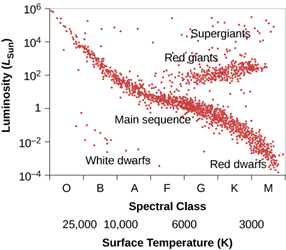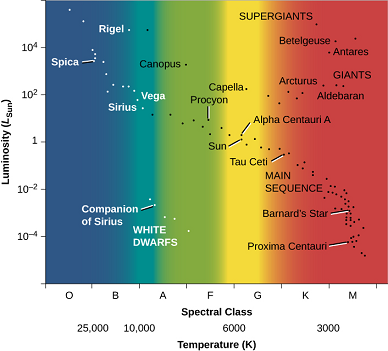
Concept explainers
If a 100 solar mass star were to have a luminosity of 107 times the Sun’s luminosity, how would such a star’s density compare when it is on the main sequence as an O-type star, and when it is a cool supergiant (M-type)? Use values of temperature from Figure 18.14 or Figure 18.15 and the relationship between luminosity, radius, and temperature as given in Exercise 18.47.

Figure 18.15 Schematic H−R Diagram for Many Stars. Ninety percent of all stars on such a diagram fall along a narrow band called the main sequence. A minority of stars are found in the upper right; they are both cool (and hence red) and bright, and must be giants. Some stars fall in the lower left of the diagram; they are both hot and dim, and must be white dwarfs.

Figure 18.14 H−R Diagram for a Selected Sample of Stars. In such diagrams, luminosity is plotted along the vertical axis. Along the horizontal axis, we can plot either temperature or spectral type (also sometimes called spectral class). Several of the brightest stars are identified by name. Most stars fall on the main sequence.
Want to see the full answer?
Check out a sample textbook solution
Chapter 18 Solutions
Astronomy
Additional Science Textbook Solutions
Physics for Scientists and Engineers: A Strategic Approach, Vol. 1 (Chs 1-21) (4th Edition)
Applied Physics (11th Edition)
University Physics Volume 3
Introduction to Electrodynamics
Cosmic Perspective Fundamentals
Sears And Zemansky's University Physics With Modern Physics
- For a main sequence star with luminosity L, how many kilograms of hydrogen is being converted into helium per second? Use the formula that you derive to estimate the mass of hydrogen atoms that are converted into helium in the interior of the sun (LSun = 3.9 x 1026 W). (Note: the mass of a hydrogen atom is 1 mproton and the mass of a helium atom is 3.97 mproton. You need four hydrogen nuclei to form one helium nucleus.)arrow_forwardAccording to the text, a star must be hotter than about 25,000 K to produce an H II region. Both the hottest white dwarfs and main-sequence O stars have temperatures hotter than 25,000 K. Which type of star can ionize more hydrogen? Why?arrow_forwardDescribe the evolution of a star with a mass similar to that of the Sun, from the protostar stage to the time it first becomes a red giant. Give the description in words and then sketch the evolution on an HR diagram.arrow_forward
- The text says a star does not change its mass very much during the course of its main-sequence lifetime. While it is on the main sequence, a star converts about 10% of the hydrogen initially present into helium (remember it’s only the core of the star that is hot enough for fusion). Look in earlier chapters to find out what percentage of the hydrogen mass involved in fusion is lost because it is converted to energy. By how much does the mass of the whole star change as a result of fusion? Were we correct to say that the mass of a star does not change significantly while it is on the main sequence?arrow_forwardWe can estimate the masses of most of the stars in Appendix J from the mass-luminosity relationship in Figure 18.9. However, remember this relationship works only for main sequence stars. Determine which of the first 10 stars in Appendix J are main sequence stars. Use one of the figures in this chapter. Make a table of stars’ masses. Figure 18.9 Mass-Luminosity Relation. The plotted points show the masses and luminosities of stars. The three points lying below the sequence of points are all white dwarf stars.arrow_forwardA supernova can eject material at a velocity of 10,000 km/s. How long would it take a supernova remnant to expand to a radius of 1 AU? How long would it take to expand to a radius of 1 light-years? Assume that the expansion velocity remains constant and use the relationship: expansiontime=distanceexpansionvelocity .arrow_forward
 AstronomyPhysicsISBN:9781938168284Author:Andrew Fraknoi; David Morrison; Sidney C. WolffPublisher:OpenStax
AstronomyPhysicsISBN:9781938168284Author:Andrew Fraknoi; David Morrison; Sidney C. WolffPublisher:OpenStax Stars and GalaxiesPhysicsISBN:9781305120785Author:Michael A. Seeds, Dana BackmanPublisher:Cengage Learning
Stars and GalaxiesPhysicsISBN:9781305120785Author:Michael A. Seeds, Dana BackmanPublisher:Cengage Learning Foundations of Astronomy (MindTap Course List)PhysicsISBN:9781337399920Author:Michael A. Seeds, Dana BackmanPublisher:Cengage Learning
Foundations of Astronomy (MindTap Course List)PhysicsISBN:9781337399920Author:Michael A. Seeds, Dana BackmanPublisher:Cengage Learning Stars and Galaxies (MindTap Course List)PhysicsISBN:9781337399944Author:Michael A. SeedsPublisher:Cengage Learning
Stars and Galaxies (MindTap Course List)PhysicsISBN:9781337399944Author:Michael A. SeedsPublisher:Cengage Learning



